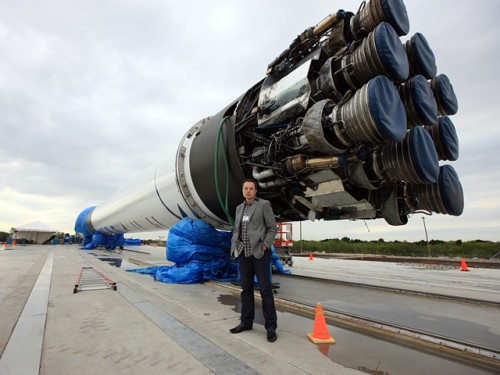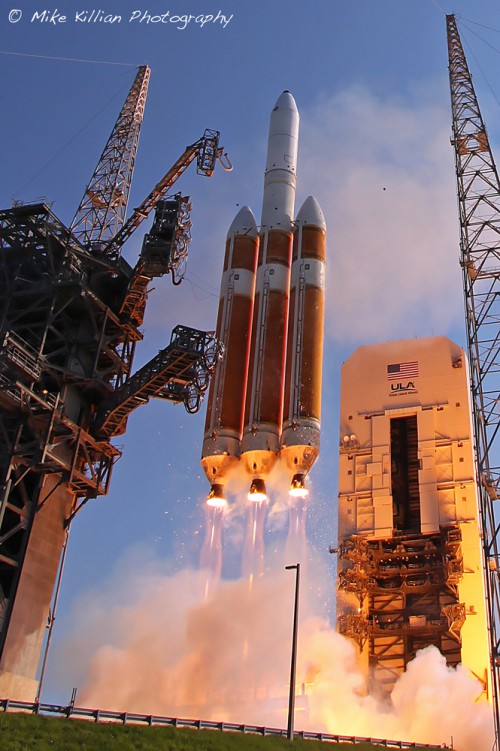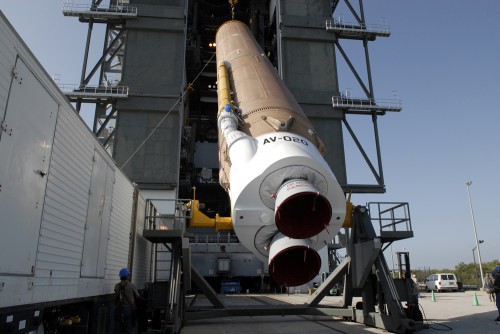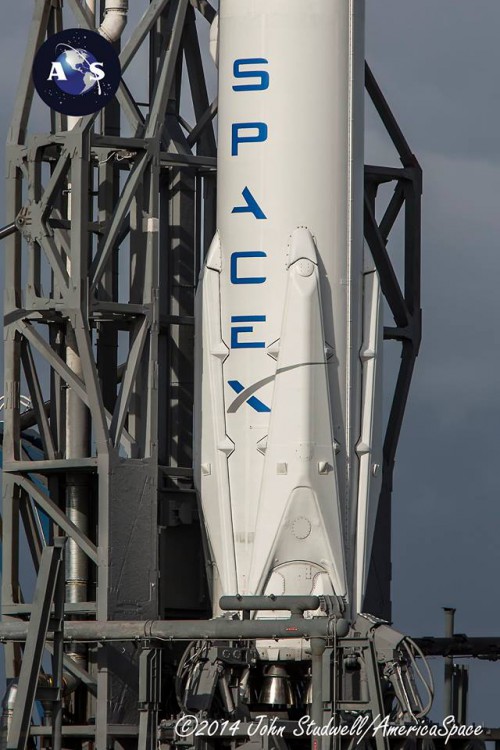
It is no secret in the aerospace community that United Launch Alliance (ULA) has a monopoly over the U.S. government’s satellite launch services; they have essentially owned the market since 2006. However, if Space Exploration Technologies (SpaceX) CEO Elon Musk has his way, that may soon change, because on Friday, April 25, Musk announced that his Hawthorne, Calif.-based aerospace company is filing suit in the Court of Federal Claims against the U.S. Air Force’s recent “bulk buy” purchase with ULA. The purchase totals nearly $3 billion for 14 out of 36 required rocket cores from ULA on a sole-source basis, while an additional 14 missions would be awarded competitively (seven of those missions are no longer up for grabs). Musk, however, has not been shy in publicly protesting the fact that SpaceX cannot yet compete against ULA for those contracts, and now it appears he has officially declared war on ULA’s monopoly.
“This is not SpaceX saying these launches should be awarded to us. If we compete and lose, that’s fine, but why are they not even competed? That is not right,” said Musk in his announcement on Friday. “The ULA rockets are basically four times more expensive, and this contract is costing us taxpayers billions of dollars for no reason … I don’t know why they’re so expensive.”

ULA’s reliability is unquestionable; there is no doubt they can get the job done—quickly—but Musk and SpaceX claim they can save the government and U.S. tax payers a whopping $300 million—per launch—a cost savings which, in many cases, would pay for both the launch and satellite combined, according to Musk.
“The Air Force and other agencies are simply paying too high a price for launch, and prices have risen to unsustainable levels,” said Musk at a congressional hearing last March. “SpaceX was founded to make radical improvements to space transport technology, with particular regard to reliability, safety and affordability. If you took something like a GPS satellite, which is about $140 million, you could actually have a free satellite with our launch, because our launch plus the satellite would cost less than just their launch – which is an enormous difference. Had SpaceX been awarded the missions ULA received under its recent non-competed 36 core block buy we would have saved the tax payers $11.6 billion dollars.”
This is not the first time Musk and SpaceX have filed suit against their competition. In 2006, U.S. Federal District Court Judge Florence-Marie Cooper of the Central District of CA dismissed SpaceX’s anti-trust lawsuit against the proposed launch services partnership between Boeing and Lockheed Martin (which went on to become ULA). In her remarks on the ruling, Judge Cooper said: “SpaceX’s argument is utterly devoid of any concrete factual allegations regarding any type of actual injury suffered. SpaceX is not yet ready to compete against Boeing and Lockheed Martin to win government launch contracts under the U.S. Air Force’s Evolved Expendable Launch Vehicle (EELV) program.”
At the time of the ruling in February 2006, SpaceX had yet to launch a EELV-class Falcon-9 rocket, so the company didn’t even have a launch vehicle capable of competing with the Delta-IV or Atlas-V fleet of Boeing/Lockheed rockets. Musk claimed the two companies “engaged in an unlawful conspiracy to eliminate competition in, and ultimately to monopolize, the government space launch business.”

The judge disagreed, saying “Because it lacks such readiness, its speculative claims regarding future harm are not ripe.” With that said, Judge Cooper dismissed Musk’s claim and paved the way for the formation of ULA, which is now the sole launch provider for the Department of Defense. However, in the time since the ruling in 2006, SpaceX has become a force to be reckoned with. The company currently has a $1.6 billion Commercial Resupply Services (CRS) contract for 12 missions to deliver cargo and supplies to the International Space Station for NASA, as well as a backlog of nearly 50 launches on the company’s manifest, both commercial and NASA missions, which represents nearly $5 billion in contracts.
ULA has delivered an impressive 100-percent mission success over 70 launches with the company’s workhorse Delta-IV and Atlas-V launch vehicles. The company has launched billions of dollars worth of satellites and spacecraft for the DOD and NASA, but over the last several years overall launch costs have more than doubled annually to $1.6 billion. That sobering fact has not only concerned the taxpayers, Elon Musk and SpaceX, but it has also raised concerns in the U.S. Senate Appropriations Subcommittee on Defense.
“The safety record of the Atlas-V and Delta-IV rockets made by ULA is remarkable, but we do have some concerns about the acquisition strategy, cost, and future of that program,” said Illinois Senator and panel chairman Richard Durbin at a hearing on National Security Space Launch Programs on March 5. “From 2011 to 2014 the amount the Air Force budgeted, for an average of six satellite launches per year, grew by 60 percent. Over the last three years the Air Force has tried to control costs by stabilizing ULA production with a block buy of 36 rockets while fostering competition from new entrants such as SpaceX. The subcommittee needs to better understand the cost of the current program, how to ensure competition is fair and presents the best value to the government, and whether we need to do more to ensure we can deliver satellites on orbit in the most efficient and affordable manner.”
Durbin added: “Can the Pentagon learn to live with only one major supplier of rockets by better managing that industrial capability, with smarter buying and better negotiating? Or should the Dept. of Defense be more forward-leaning and embrace companies that challenge the rules on how we normally run defense programs?”
Musk has also continued to emphasize the fact that ULA’s rockets are dependent on Russian hardware, which—in light of recent events across the Pacific—he believes could potentially cause problems to America’s ability to launch national security payloads should U.S./Russian relations deteriorate further.

“Our Falcon launch vehicles are truly made in America, designed in California and Texas, with key suppliers spread across the country, and we launch from either Vandenburg Air Force Base or Cape Canaveral Air Force Station,” said Musk. “This stands in stark contrast to the ULA’s most frequently flown vehicle, the Atlas-V, which uses a Russian main engine and where approximately half the airframe is manufactured overseas. In light of Russia’s de facto annexation of the Ukraine’s Crimea region and the formal severing of military ties, the Atlas V cannot possibly be described as providing ‘assured access to space’ for our nation when supply of the main engine depends on President Putin’s permission. Given this development, it would seem prudent to reconsider whether the 36 core uncompeted, sole source award to ULA is truly in the best interests of the people of the United States.”
ULA CEO Michael Gass countered at the March hearing by noting the fact that ULA has a two-year supply of those Atlas-V RD-180 engines stockpiled to minimize potential supply disruptions. According to Gass, ULA also has the blueprints and specifications for the engine and even developed significant engineering and manufacturing capability which ultimately demonstrated the capability to co-produce the RD-180 domestically.
“I believe there are substantive questions about how EELV competitions will be structured to ensure the competition is fair and open and whether it will actually deliver savings to our nation,” said Gass. “Ultimately, the central question is whether savings from competition will be sufficient to offset the cost of duplicating existing capabilities. ULA was formed to enable assured access to space with two separate launch systems, with recognition that the market demand was insufficient to sustain two competitors. We went from two competing teams with redundant and underutilized infrastructure to one team that has delivered the expected savings of this consolidation. We are investing in new technology and concepts to make our products better and more affordable. We are investing internal funds to develop a capability to launch two GPS satellites at a time which will cut launch costs almost in half.
“I believe leveraging the demand from the commercial sector is smart, but relying on commercial demand to enable national security carries huge risks, both to the rocket supplier and to its government customers,” added Gass. “ULA’s Atlas V and Delta IV rockets are the most powerful and most reliable in the world. They are the only rockets that fully meet the unique and specialized needs of the national security community. I believe the EELV program has been a major success for the nation. We will continue to provide the assured access the nation needs to deliver critical capabilities to orbit reliably and on-schedule.”

Another weapon in SpaceX’s push to revolutionize the space launch services industry is their work to develop reusable rockets, which could, according to Musk, reduce costs by up to 70 percent. Just last week the company launched their third contracted ISS resupply flight for NASA and attempted a controlled vertical landing of their Falcon-9 rocket in the Atlantic Ocean off Florida’s coast. Though the landing itself appears to have went very well, the rough seas and strong storm in the landing area destroyed the rocket. SpaceX will try again for a future unspecified launch.
SpaceX recently finalized a deal with NASA to lease the agency’s historic Kennedy Space Center Launch Complex-39A, and the company currently has a $440 million deal with NASA to develop their Dragon spacecraft to support crewed missions—in addition to the $1.6 billion contract for unmanned Dragon flights to resupply the ISS. However, if SpaceX ever hopes to compete with ULA for military launch contracts, then they will be required to have vertical integration capability, as the U.S. Air Force will not consider horizontal integration for their national security assets (SpaceX currently conducts horizontal integration). The company has already received $4.2 million in funds from the USAF for early integration studies, and the USAF has even stated the SpaceX Falcon-9 v1.1 rocket should be certified in time to compete for the FY17 launches.
Given all of this information, it’s safe to assume that both the U.S. government and the U.S. Air Force welcome allowing SpaceX to bid on launch contracts for the country’s most sensitive national security space assets, rather than paying four times more for ULA to carry out the same service. How it will all play out in court? We will have to wait and see.
“If our rockets are good enough for NASA and supporting a $100 billion space station, then why aren’t they good enough for the Air Force? It makes no sense.” — Elon Musk
Want to keep up-to-date with all things space? Be sure to “Like” AmericaSpace on Facebook and follow us on Twitter: @AmericaSpace




Nicely done, Mike!
“Given all of this information, it’s safe to assume that both the U.S. government and the U.S. Air Force welcome allowing SpaceX to bid on launch contracts for the country’s most sensitive national security space assets, rather than paying four-times more for ULA to carry out the same service. How it will all play out in court? We will have to wait and see..”
If it is true that “it’s safe to assume that both the U.S. government and the U.S. Air Force welcome allowing SpaceX to bid on launch contracts for the country’s most sensitive national security space assets”, then why is the lawsuit necessary.
Why not just have Congress (with strong support from the DoD) pass legislation to change the military launch procurement policies, then the President signs them into law.
No lawsuit required.
Being that the U.S.Air Force has already given ULA those non-competed contracts I imagine the suit, if it is ruled in SpaceX’s favor, would re-open the bidding on that $3 billion block buy that was given to ULA so SpaceX can bid on it too.
Hi Mike,
I am not trying to make this into a food fight.
But that does not answer the question.
If it is true that “it’s safe to assume that both the U.S. government and the U.S. Air Force welcome allowing SpaceX to bid on launch contracts for the country’s most sensitive national security space assets”, then it should be possible (without the years likely to be required for the suit and appeals)to change the legal situation by legislation supported by the Congress, and President (with strong public backing by the Air Force – in public Congressional hearings).
No lawsuit required.
So the gloves are off!
This is largely about the 14 launches that were supposed to be bid in 2015 to 2017. The military has cut that to 7 (with possibly an 8th one in the near future) and deferred 5 to beyond 2017. What he’s really upset about is a small number of launches he won’t be able to bid on until later than originally planned.
That would seem to be a rather small issue when you get right down to it, so Musk focused on the entire 36-core deal which he could legally challenge. Meanwhile, SpaceX already has dozens of satellite on a manifest that keeps sliding to the right. It has failed to establish any sort of regular schedule for missions, which is pretty key for military launches. And it hasn’t gotten Falcon 9 certified yet, much less even flown Falcon Heavy. The company’s case would be stronger if it had flown more by now.
As the author points out, a shortage of results has never stopped Musk from going to court to claim how much he’s being screwed over. He’s got much more accomplishes under his belt now, but he’s not quite there yet.
SpaceX will regret the decision to try and enter this market and as soon as the Space station supply contract is done hopefully they will let others provide that service…They need to concentrate on the commercial market exclusively and work on taking paying human customers to off earth destinations period.
Why would any business pass on an existing market for one that does not yet exist?
Ken,
Musk just said he expects to land the first stage at the Cape by years end and reuse the stage next year. He said that with complete reuseability a $60,000,000 launch cost will be reduced by 100 fold or a factor of 2 which is a F9 launch cost of $600,000. He also indicated that it must be able to relaunch in the same day…
So I expect to see reduction in launch costs starting 2015 from SpaceX which will cause their launch manifest to expand greatly and quickly…I would not be surprised that by the end of 2015 SpaceX is launching weekly….end of 2016 launching daily or every other day and by the end of 2017 SpaceX will be launching multiple times per day…
All of this being achieved without the hinderence of government red tape. Musk will soon realize that government launch work will slow his development progress to a crawl and will then decide to forgo that market…
While govt. has hindered them from doing things for the govt. There is no evidence it has hindered them from commercial activity with one possible exception that SpaceX is working hard to correct: launch facilities.
They have departments for dealing w/ govt. b.s. This isn’t 2002. SpaceX has grown beyond that.
I would agree that more commercial and less govt. is wise.
Ken,
Thats my point they will need to move away from government work if they are to progress to a 100% reusabile design ability…I don’t think NASA will allow reused systems on anything they would contract them to do…Which kinda is the reason that the military wants to continue to use ULA for military launch. The relationships are known and the products are completely reliable…Yes it is expensive but if “it ain’t broke don’t fix it”…Besides once SpaceX has acheived the reuse of daily launch then I believe they will look to turn it over to operators like the airline business to expand their base over the entire planet…
SpaceX gets an injunction to prevent ULA from importing any more rocket engines….Doesn’t ULA already have an inventory of about 19 rockets in the Barn ready to go? This is like 3 years worth….Why bother?
NASA may not, but reuse requires first use which NASA gives them.